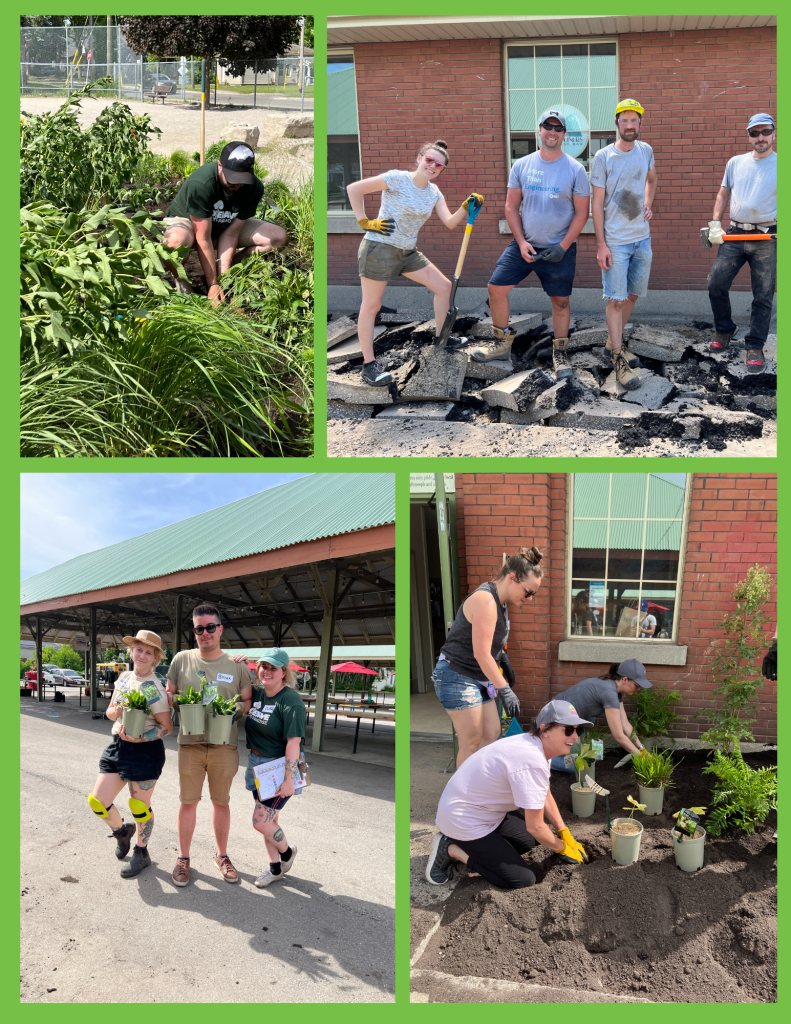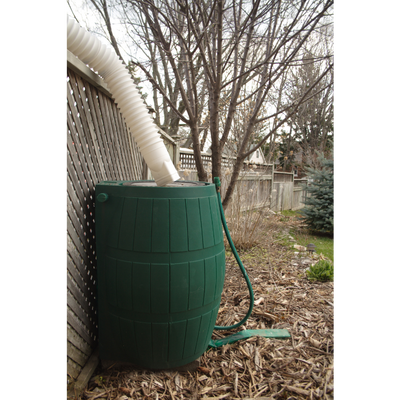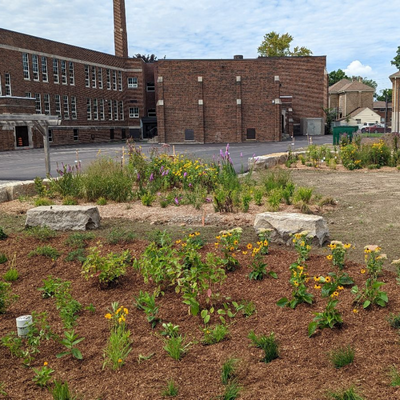What is green stormwater infrastructure?
Green stormwater infrastructure – or low impact development (LID) – has emerged as a nature-based solution to improve stormwater management throughout a drainage area. LID aims to capture, store, and cleanse stormwater runoff by using both natural features and processes and human-made elements to restore ecological and hydrological functions.
Benefits include:
- Returns stormwater runoff to the natural hydrologic cycle
- Reduces runoff volumes, pollutant loads, flood risk, peak stormwater discharges, and even community water use
- Cost-effective addition to traditional stormwater infrastructure
- Adds value to communities via improvements to air quality, climate resiliency, recreation, and human health.
Examples of LID:
- rain barrels,
- green roofs,
- rain gardens,
- bioswales,
- permeable pavers,
- urban tree canopies, and
- greenspaces.
Why do we need green stormwater infrastructure?
Due to climate change, many parts of the world will experience increased total precipitation and increased frequency of extreme rainfall events over the next century. Urban areas are particularly threatened by this increased rainfall intensity. Impervious surfaces – such as paved parking lots, sidewalks, roads, buildings, or structures, etc. – prevent or slow absorption of stormwater into the soil. Decreased absorption of water in urban areas can cause increased runoff, reduced groundwater recharge rates, decreased water quality, and increased flooding and soil erosion.
In Ontario, conventional stormwater systems were not designed to manage the current and increasing intensity and frequency of precipitation. These systems now require upgrades, maintenance, and have capacity issues. Extreme precipitation events can overcome a stormwater system and cause flooding resulting in loss of life, property damage, sewer system failure, water pollution, and/or watershed deterioration. LID is an important component of climate change-adapted stormwater management that can support the economic, social, and environmental wellbeing of communities.
If you have any interests in completing or supporting a green stormwater infrastructure project, please reach out to kaitlin@londonenvironment.net from Green Economy London for support.
Local Examples of Green Stormwater Infrastructure
As of 2016, the City of London has been incorporating low impact developments into design and construction projects to optimize the water resources system and increase the resiliency of infrastructure against climate change. Currently, there are several green infrastructure initiatives that seek to reduce impervious surfaces in the City of London and to reduce stormwater contamination and runoff into the Thames River.
City of London Stormwater Rate Reduction Program
In the City of London, developed parcels with a municipal water service pay a stormwater charge on their London Hydro water utility bill. In accordance with Municipal By-law WM-28 (Section 3.4.2), the City of London has a reduction program for stormwater rates up to 50% for Industrial, Commercial and Institutional (ICI) properties over 0.4 hectares. To receive a reduction, applicants must submit a Stormwater Rate Reduction Application alongside required supporting documents such as a storm drainage report, prepared by a professional engineer, showing that the site has stormwater management practices that go above and beyond established stormwater requirements for review and acceptance by the City and the City Engineer. The intent of this program is to recognize ICI properties that are discharging a low volume of runoff to the municipal system through increased pervious area and/or through the construction of green stormwater infrastructure that improves infiltration. For more details on eligibility for this program, visit the Stormwater Rate Reduction Program tab on the City of London website.
Depave Paradise
Depave Paradise is one of the London Environmental Network’s programs that aims to replace underutilized, paved sites of 100 meters squared or more with native, stormwater retentive plants and pollinator gardens in London and surrounding communities. There have been three events held so far in 2021 and 2022. In 2022, with the support from volunteers, the program removed unnecessary pavement from the Jeanne Sauve French Immersion Public School playground to replace it with large gardens full of native plants and removed pavement. Over 60 individual plants were added from 22 different native plant species. The site features armourstone seating facing the school and a sign to educate the public about the local pollinator species located in the new gardens.
At the Horton Farmers’ Market in St. Thomas, 70 square meters of under-utilized pavement was removed and replaced with a garden featuring over 75 native plants. In 2021, with the help of 59 volunteers, the program depaved approximately 118 square metres of underutilized pavement in the neglected Arts Courtyards at Fanshawe College and replaced it with porous pavement and a rain and pollinator garden. The gardens featured over 150 native plants and two trees.
You can follow along for project and event updates by signing up for the London Environmental Network’s newsletter!

Featured Business: Enviro-Stewards
Enviro-Stewards provides innovative solutions to improve business facilities in terms of energy , water and product yields, shrinking environmental footprints, and growing margins. Their engineers and scientists offer a consultative and analytical approach in order to implement practical, measurable, and economically feasible solutions to guide your organization to long-term, sustainable, and financial success. Enviro-stewards provides solutions for sustainability, energy efficiency, water conservation, food loss & waste reduction, net zero, blue roofs, pollution prevention, and wastewater treatment.
Blue roofs are an emerging rainwater collecting technology that stores stormwater on roofs. This solution can help with flood prevention, water and energy conservation, and reduce stormwater infrastructure costs. Enviro-Stewards offers an Affordable Smart Blue Roof (ASBR) system that can be installed on buildings. This system stores water on the roof from the rain to provide thermal benefits and be stored in a tank for water reuse. The technology of the roof can control when water is drained, store a predetermined amount of water and flush the stored water to free up capacity. Watch the video of the first installation of an ASBR on their head office building in 2021 here.
Another project by Enviro-Stewards is Safe Water Social Ventures. These projects focus on prevention, training, tools, and mentoring to provide safe water to communities. With biosand filters that are easy to maintain and can be constructed locally, communities can build a local economy through purchasing water and have a clean and healthy source of drinking water. The outcomes of the projects are described further here.
For more information on Enviro-Stewards and/or to consult with them, please visit their website.

